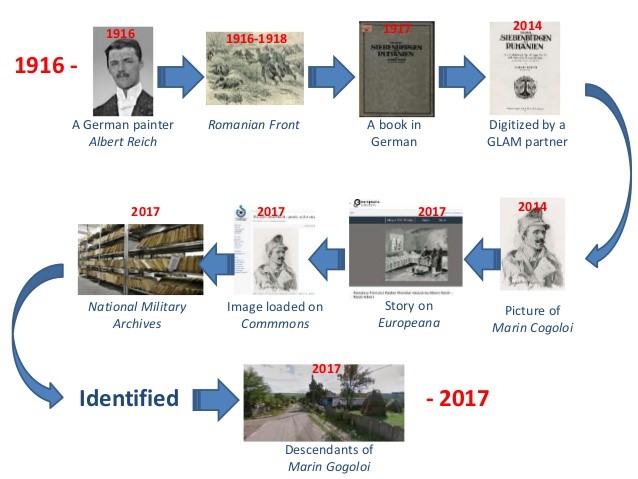The story of Marin Gogoloi: a ’Wiki-Europeana’ odyssey of a World War I soldier
In October, Members of Romania’s Wikimedia community received the overall prize in the Wikimedia 1914-18 Europeana Challenge for their portfolio of work. Măcreanu Iulian was the Coordinator of the Wikimedians of Romania portfolio and spoke at the recent Europeana AGM in Milan about a specific image he came across during the competition. He tells us the touching story behind it...

- Title:
- Macreanu Iulian, project representative. Photo by staff photographer/Europeana AGM 2017, CC BY-SA 4.0
- Copyright:
- CC BY-SA
In August 1916, Romania entered in war against the Central Powers. In turn, Germany decided to send the 9th Army on the new Romanian Front. Together with the elite German unit was Albert Reich, a young painter working as a front reporter who, later on, would became famous. During the course of the Romanian campaign he produced more than 100 engravings, not only depicting scenes from the front, but also people, villages and landscapes. In 1917, Reich published a book of his engravings, Durch Siebenbürgen und Rumänien, which remained mostly unnoticed in the aftermath of the war.
In 2014, as part of a europeana project, the Berlin State Library digitised the book, and made it available to the public. Recently, our team of Wikipedia Romania extracted and annotated individual images from the book, published the story on Europeana 1914-18, and transferred the images to Wikimedia Commons. One of them represented a young Romanian soldier taken prisoner by the German troops. Looking closely at the photo, I found out that that particular soldier was named Marin Gogoloi, from Romanian 56th Infantry Regiment according to the plate number of his cap.

Albert Reich, generic, soldat roman prizonier, public domain
I became intrigued, and I made an inquiry to the Romanian Military Archives. They confirmed that the soldier Marin Gogoloi did exist, and provided us with his birthplace, a remote village in the county of Suceava. We emailed the mayor of that commune, asking if they could provide any further information about the soldier. To our surprise, they answered that Marin Gogoloi did live there, before moving to another village where he died around 1960. They also identified a grandson of Gogoloi – currently aged about 75, who confirmed that he was the man from the photo. The family didn’t have any other picture of him, and the Albert Reich engraving is now their only pictorial memory of their ancestor.

Our big world is made of billions of small worlds: if we can have impact on a family or even one person, it means we can change the world with culture. It also changes the perspectives over the people and events. Marin Gogoloi is no longer the humble Romanian soldier made prisoner of war; he is now connected with history, being immortalized by a German painter, and his portrait is available to millions of users of Europeana and Wikimedia.
Learn more about Romanian Wikimedia community’s participation in the Wikimedia 1914-18 Europeana Challenge on Wikimedia’s blog

